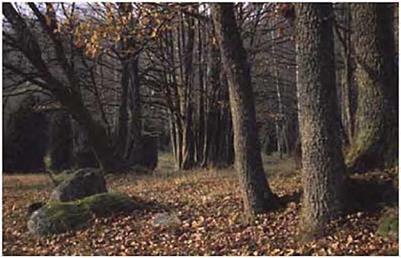One of the most interesting woodland design concepts is the ‘wood pasture’ of open woodlands, with a grassy layer beneath the trees that would traditionally be open to grazing animals. In Britain we have to go back to medieval times to find systems expressed in very old-landscape words, such as ‘silva pastilis’ (wood pasture) and ‘denes’ (swine pastures) (Muir 2000). In Southern European countries, such as Portugal, the chance is greater through their still-living ‘silvi-pastoral’ system of ‘montado’ (Figure 7.3). Also in Sweden, Norway and Finland, and in the Baltic countries, these kinds of grazed or hayed tree – and shrub-rich landscapes are still found quite easily, and an increasing amount are also being restored to be part of the urban landscape (Figures 7.4 and 7.5). Here, such design concepts should be considered as a rediscovery today, due to their influence in park and garden design in the so called ‘Stockholm School’ up until the 1950s (Bucht 1997, 2002). Even in the Netherlands, despite
|
|
7.3 (a) and (b)
The wooded meadow Laxareanget on the island of Gotland in the Baltic sea. Many of the traditional wooded meadows were grazed during a short period in the autumn, but the basic management of the grass sward was hay cutting. The photographs show two different degrees of closeness, the characteristic shift inbetween storrum (‘large room’) with a dominance of grasses and lightdemanding herbs, open corridors as enclosed rooms with colourful carpets of flowers up until about midsummer, hundreds of pollards of lime-trees and ashes, and interior woodland entities with a few large trees in an interaction with coppiced multi-stemmed trees and shrubs
|
having virtually no living remnants of old woodlands, a somewhat similar half-open, grazed landscape has been regarded as belonging to an important part of the future landscape for recreation and nature conservation. The Dutch have, in several places since the 1980s and 1990s, succeeded in reconstructing and putting into practice a complex
|
7.5
A grazed, half-open landscape from Sweden that was the inspiration for one of the most well-known nature parks in Warrington New Town, which was designed in the 1980s.
The existing cluster of elements, the richness of form, symbolised by the shift between one, two, five, ten, or even more than 30 stems in one single tree clump, provide a base for impressionistic gradients in openness and closeness in a longterm sustainable pattern. Later, the same area was chosen for a PhD study about landscape perceptions and the attractiveness of grazed countryside landscapes. Out of 60 different areas, this area was chosen as one of the most attractive areas in southern Sweden by city dwellers from a sample of 120 people (Hagerhall 1999)
open or half-open landscape with, probably, a similar character to what existed before
‘the farming culture’ came to totally dominate the European countryside (Vera 2000).





